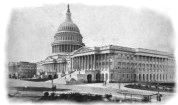Streets and Wards of Washington, DC
Streets
Generally the streets run three ways: east-west, north-south, and diagonally. East-west street are designated alphabetically; north-south streets are designated numerically; and diagonal streets have state names.
The alphabetical designated streets running east-west begin on each side of East Capitol Street and the Mall. The first street on each side is A, the next is B, and so forth. Once the letters of the alphabet are exhausted, the streets have two-syllable names, then three, and then names of trees and flowers--all in alphabetical order.
The numerical designated streets running north-south begin on each side of North and South Capitol Streets. The first street on each side is First Street, the next is Second Street, and so on.
The District is divided into four sections by the intersection at the U.S. Capitol of East Capitol Street and the Mall with North and South Capitol Streets. These four sections are Northwest (NW), Northeast (NE), Southwest (SW), and Southeast (SE). District streets are identified with a name and the section of the city in which they are located--for example: Pennsylvania Ave. NW.
Odd house numbers are on the right when you stand with your back to East Capitol or North Capitol or South Capitol Streets or the Mall.
Source: publication of DC Dept. of Transportation
Wards
Moreover, the character of public assistance extended to needy families depended in considerable part upon where they lived. For the method the city early adopted in distributing funds for poor relief, policing, and other public purposes penalized the poorer parts of the city. Each ward collected its own taxes, paid a small part into the city treasury and spent the rest within its own limits; each ward independently solicited contributions for relief of its own poverty-stricken inhabitants.
After 1820 when a rearrangement made six wards out of the original four, the second and third wards were the wealthiest, and, because they could afford expensive improvements, the area above southwest E Street stretching from the Capitol to the Treasury rapidly drew to itself the most enterprising householders. The wards to the northeast and along the river front, where poor people lived and where want was greatest, lost progressively the capacity to attract the well-to-do.
The previous two paragraphs refer in footnotes to the following reference documents:
Washington Acts, May 10, 1816; Washington Laws,
April 4, May 22 and 24, June 1, 1820;
National Intelligencer
Jan. 31, 1816, Jun. 2, 1819, May 22, 1821, and May 17, 1822.
The Wards in 1832:
| Ward | # of Inhabitants | Tax Assessment |
|---|---|---|
| 1st Ward | 3678 | 1,573,477 |
| 2nd Ward | 4058 | 1,617,133 |
| 3rd Ward | 5750 | 2,438,610 |
| 4th Ward | 1859 | 588,823 |
| 5th Ward | 1357 | 533,871 |
| 6th Ward | 2138 | 463,435 |
Source: Washington, Village and Capital, 1800-1878 by Constance McLaughlin Green, 1962.
The ward system was done away with after 1871. Prior to that there were Ward Maps done for 1868, 1855, 1846, 1836, and 1829. Microfilm for these are available from the LDS (Latter Day Saints) Family History Centers. It is FHL film # 1377700 and can be rented from any center for a modest fee.
All DC census from 1880 to date use the enumeration district system for locating people.

